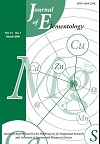Applicability of different kinds of yeast biomass to lead removal from water
Wydanie: 1/2012
Otrzymano: Brak danych
Zaakceptowano: Brak danych
Opublikowano online: Marzec 18, 2012
Autorzy:
Brak danych
Kategorie: Pollution and environment
DOI: 10.5601/jelem.2012.17.1.01
Abstrakt:
The aim of the study was to assess the possibility of using different yeast biomasses for lead removal from aqueous solution. The material for the study comprised baker’s yeast(BY), spent waste brewer’s yeast (WBY), and fodder yeast (FY), which can be easily obtained as production waste. An amount of each yeast biomass (BY, FY, or WBY) that equals 0.1 g of dry weight was suspended in 100 cm3 of lead solution (concentration of 200, 500,or 1000 mg dm–3) and biosorption was carried out for 20, 40, 60, 90, 120, 240, and 300 minutes. The concentration of lead remaining in solution was determined using atomic absorption spectroscopy. The lead uptake by yeast biomass was calculated using the massbalance equation for the biosorbent and the results were fitted to the Langmuir isotherm model. The yeast biomasses were able to remove more than 90% of lead present in solution within 20 minutes. With BY biomass, it was possible to reduce the lead level below1mg dm–3 from the initial lead solutions of 200 and 500 mg Pb dm–3. The value of qmaxand affinity parameter b, calculated for BY after 300 minutes of biosorption, were veryhigh (1,250 mg Pb g–1 d.w. and 0.363, respectively). The best efficiency was achieved for BY when the initial concentration of lead was 500 mg dm–3. The final concentration of the metal (after 300 minutes of sorption) was 0.66 mg dm–3, which means that 99.86% of lead was removed from the solution by the biomass of baker’s yeasts.
Cytacja:

Duda-Chodak A., Tarko T., Milotta K. 2012. Applicability of different kinds of yeast biomass to lead removal from water. J. Elem. 17(1): 7-18, DOI - 10.5601/jelem.2012.17.1.01.
Słowa kluczowe:
lead, toxicity, biosorption, waste treatment, yeasts, waste yeast, Langmuir isotherm
O wydaniu:

17.1.2012
Jsite


